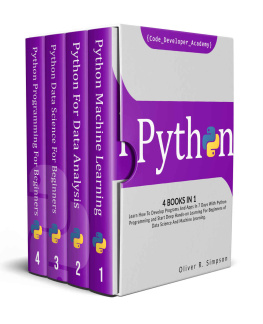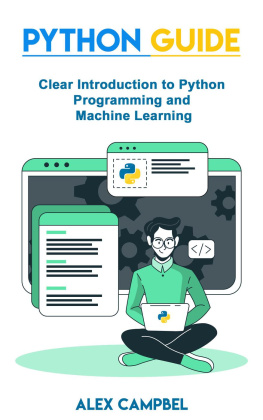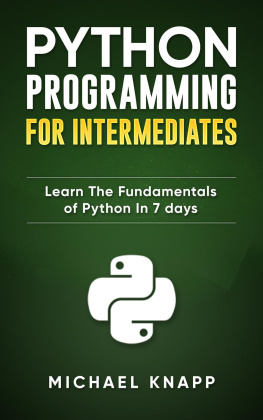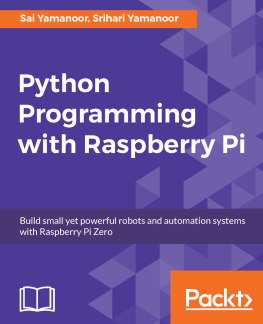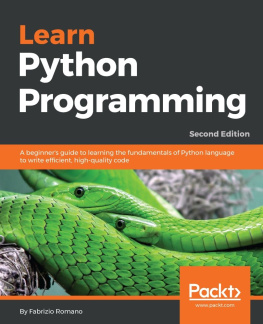Oliver R. Simpson - PYTHON: 4 BOOKS IN 1: Learn How To Develop Programs And Apps In 7 Days With Python Programming And Start Deep Hands-on Learning For Beginners of Data Science And Machine Learning.
Here you can read online Oliver R. Simpson - PYTHON: 4 BOOKS IN 1: Learn How To Develop Programs And Apps In 7 Days With Python Programming And Start Deep Hands-on Learning For Beginners of Data Science And Machine Learning. full text of the book (entire story) in english for free. Download pdf and epub, get meaning, cover and reviews about this ebook. year: 2020, genre: Romance novel. Description of the work, (preface) as well as reviews are available. Best literature library LitArk.com created for fans of good reading and offers a wide selection of genres:
Romance novel
Science fiction
Adventure
Detective
Science
History
Home and family
Prose
Art
Politics
Computer
Non-fiction
Religion
Business
Children
Humor
Choose a favorite category and find really read worthwhile books. Enjoy immersion in the world of imagination, feel the emotions of the characters or learn something new for yourself, make an fascinating discovery.
- Book:PYTHON: 4 BOOKS IN 1: Learn How To Develop Programs And Apps In 7 Days With Python Programming And Start Deep Hands-on Learning For Beginners of Data Science And Machine Learning.
- Author:
- Genre:
- Year:2020
- Rating:5 / 5
- Favourites:Add to favourites
- Your mark:
PYTHON: 4 BOOKS IN 1: Learn How To Develop Programs And Apps In 7 Days With Python Programming And Start Deep Hands-on Learning For Beginners of Data Science And Machine Learning.: summary, description and annotation
We offer to read an annotation, description, summary or preface (depends on what the author of the book "PYTHON: 4 BOOKS IN 1: Learn How To Develop Programs And Apps In 7 Days With Python Programming And Start Deep Hands-on Learning For Beginners of Data Science And Machine Learning." wrote himself). If you haven't found the necessary information about the book — write in the comments, we will try to find it.
Did you know that there are 698 programming languages? One of them that is the easiest to master is Python. Named after Monty Pythons Flying Circus, a BBC comedy series from the 1970s, learning Python is a piece of cake if you have the right teacher. And, there is no better and more straightforward teacher than this course!
Python is a high-level programming language with dynamic semantics that emphasizes readability and ease of use. It can be used to develop websites, desktop GUI applications, and web applications.
The syntax rules of Python allow you to express concepts without writing additional code. Unlike other programming languages, Python emphasizes code readability and this programming language allows you to use English keywords instead of punctuations.
Python has an extensive and robust standard library, which makes it score over other programming languages. Besides, it is an open-source programming language that will help you curtail the cost of software development significantly.
Also, Python is designed with features to facilitate data analysis and visualization. You can use it to create custom big data solutions without putting extra time and effort. So, what stops you from using Python to design amazing apps?
Here is the problem you face: Most people are intimidated by the thought of learning how to program because it seems incredibly complicated. While programming terminologies can be intimidating at first, theyre actually quite easy to learn. Once you understand the fundamentals, everything else will be much easier.
Dont let your fear of trying something new stop you! If you have a great idea for a program or an app, but you dont know how to bring it to life, this book will be your savior.
In his book, Oliver teaches you everything there is to know about Python machine learning, data science, data analysis, and programming. Once you get the hang of the basics, this crash course will help you use all this knowledge for practical tasks and start programming in seven days!
Heres what youll discover inside this book:
- The Basics of Machine Learning: learn how to use classification algorithms and create data pipelines that are essential to machine learning
- Essential Skills for Python Programming: a straightforward guide that will turn you from a rookie into an expert in Python programming and coding
- How to Master Data Science: lessons that will teach you how to collect data from scratch, improve your skills, and become an unprecedented data scientist
- And much more!
This book is not for people who want to learn what is programming. It is for those who dream of becoming expert programmers without spending months learning the basics. The thing is, you cant learn how to program overnight. But, if you set aside some time every day to read this book and practice, then youll be able to start developing your programs and apps in no time!
If youre ready to start this journey then...
Scroll up, click on Buy Now with 1-Click, and Get Your Copy Now!Oliver R. Simpson: author's other books
Who wrote PYTHON: 4 BOOKS IN 1: Learn How To Develop Programs And Apps In 7 Days With Python Programming And Start Deep Hands-on Learning For Beginners of Data Science And Machine Learning.? Find out the surname, the name of the author of the book and a list of all author's works by series.

